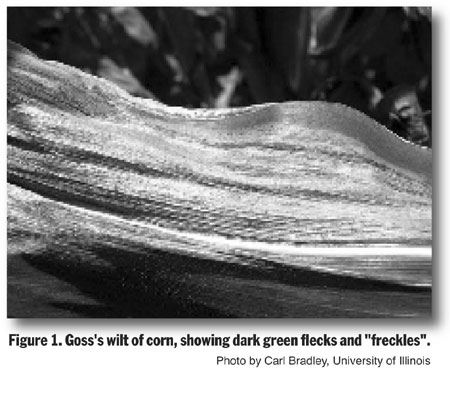Goss’s Wilt Of Corn
LEXINGTON, KY.
Goss’s wilt is a bacterial
disease of corn (dent
corn, popcorn, sweet
corn). The disease results in
long, tan spots of dead tissue
anywhere on leaves. These lesions
typically have characteristic
“freckles” (Fig. 1).
Infected leaves usually become
blighted. Crops other than corn are not
affected by this disease.
Goss’s wilt has a long history of causing problems
in several Plains states, especially in Nebraska,
Colorado and Wyoming. In the past few
years, the disease has also been found in scattered
fields in Indiana and Illinois. Aerobiology
models suggest that the bacterium may have
spread further last season, so growers along the
Ohio River should keep a watch out for this disease
in the coming growing season.
The disease doesn’t represent a dramatic new
threat to Kentucky corn. It can be very destructive,
causing losses as high as 60 bu/acre. However,
there are many hybrids with adequate
resistance to the disease, so if you have an outbreak,
selecting resistant hybrids will dramatically
reduce the risk in future plantings.

Of course, fungicides do not provide protection
against a bacterial disease like Goss’s wilt, and
there is no reason to think that other products
applied by spray application will offer any
meaningful control.
More detailed information on scouting and
recognition of Goss’s wilt will be available in
Kentucky Pest News in May, closer to the time
when you’ll want to be watching for the disease.
Δ
DR. PAUL VINCELLI: Extension Plant Pathologist,
University of Kentucky